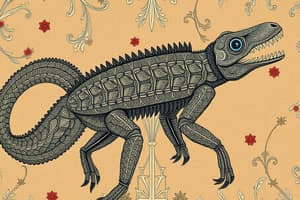Podcast
Questions and Answers
What phylum is characterized by three embryonic cell layers and a segmented body?
What phylum is characterized by three embryonic cell layers and a segmented body?
- Arthropoda
- Chordata (correct)
- Cnidaria
- Porifera
Which class of Chordata is known for being warm-blooded and having mammary glands?
Which class of Chordata is known for being warm-blooded and having mammary glands?
Mammalia
What class includes vertebrates that can live both on land and in water?
What class includes vertebrates that can live both on land and in water?
Amphibia
Which class of Chordata is characterized by cold-blooded, scaly skin?
Which class of Chordata is characterized by cold-blooded, scaly skin?
What is the defining feature of the class Aves?
What is the defining feature of the class Aves?
Which class of Chordata breathes through gills and has a bone skeleton?
Which class of Chordata breathes through gills and has a bone skeleton?
What phylum is commonly known for its sponges?
What phylum is commonly known for its sponges?
What is characteristic of the phylum Cnidaria?
What is characteristic of the phylum Cnidaria?
Which phylum is known for having hermaphroditic organisms with a complex reproductive system?
Which phylum is known for having hermaphroditic organisms with a complex reproductive system?
Which phylum has segmented bodies and a well-developed nervous system?
Which phylum has segmented bodies and a well-developed nervous system?
What is a defining characteristic of mollusks?
What is a defining characteristic of mollusks?
Which class of Mollusca lacks a head and has laterally compressed bodies?
Which class of Mollusca lacks a head and has laterally compressed bodies?
Which class of Mollusca is characterized by tentacles and the ability to squirt ink?
Which class of Mollusca is characterized by tentacles and the ability to squirt ink?
What phylum is covered with an exoskeleton and has segmented bodies?
What phylum is covered with an exoskeleton and has segmented bodies?
What class within Arthropoda has a distinct three-segmented body?
What class within Arthropoda has a distinct three-segmented body?
Which class of Arthropoda has eight legs and two sections in its body?
Which class of Arthropoda has eight legs and two sections in its body?
What class of Arthropoda typically has a well-defined head and 2+ pairs of antennae?
What class of Arthropoda typically has a well-defined head and 2+ pairs of antennae?
Flashcards are hidden until you start studying
Study Notes
Chordata
- Phylum characterized by three embryonic cell layers
- Displays segmented body and bilateral symmetry
- Features a complete digestive system and a closed circulatory system
- Possesses a centralized nervous system
- Key components include notochord, hollow nerve cord, pharyngeal pouches, and endostyle
Mammalia
- Class within Chordata, known as warm-blooded vertebrates
- Endothermic with high metabolic rates
- Distinguished by hair and mammary glands
- Examples include kangaroo, humans, and rabbits
Amphibia
- Class of cold-blooded vertebrates within Chordata
- Four-legged creatures capable of living in both land and water
- Examples include frogs, toads, salamanders, and newts
Reptilia
- Class of cold-blooded vertebrates within Chordata
- Have a multi-cellular structure and can inhabit water or land
- Characterized by scaly skin and a four-chambered heart
- Examples include turtles, crocodiles, rattlesnakes, and iguanas
Aves
- Class of vertebrates within Chordata, covered in waterproof feathers
- Endothermic and known for laying hard-shelled eggs
- Walk on two feet with forelimbs developed into wings
- Examples include ducks, owls, and penguins
Osteichthyes
- Class of cold-blooded vertebrates within Chordata
- Breathe through gills and use fins for swimming
- Composed of a bony skeleton instead of cartilage
- Examples include seahorse, American eel, and trout
Porifera
- Commonly known as sponges, these multicellular organisms are mostly marine
- Body structure is cylindrical, asymmetrical, or exhibits radial symmetry
- Primarily sedentary in nature
- Examples include orange ball sponge and liver sponge
Cnidaria
- Phylum composed of invertebrates with a radially symmetrical body
- Features a sac-like internal cavity and stinging nematocysts
- Reproduction can be asexual or sexual
- Examples include hydras, jellyfish, and corals
Platyhelminthes
- Phylum characterized by spiral cleavage and a complex, incomplete gut
- Hermaphroditic with a lack of skeleton and blood vessels
- Body is flattened on both sides
- Examples include trematodes, cestodes, and turbellarians
Annelida
- Phylum distinguished by segmented bodies
- Lacks lungs and has six major sensory structures
- Possesses ganglia segmented to assist with body control
- Examples include earthworms, leeches, and polychaetes
Mollusca
- Phylum of soft-bodied organisms with a muscular foot
- Often possess a protective shell and exhibit bilateral symmetry
- Have both a mouth and anus with an open circulatory system
- Generally reproduce sexually
Bivalve
- Class within Mollusca featuring laterally compressed bodies enclosed by two hinged shell parts
- Lack eyes and a radula
- Examples include clams, oysters, and mussels
Gastropoda
- Class within Mollusca where most have shells and a well-defined head
- Distinguished by two or more sensory tentacles
- Examples include snails and slugs
Cephalopoda
- Class within Mollusca found in all oceans and only capable of saltwater survival
- Characterized by symmetrical bodies and tentacles
- Known for their ability to squirt ink
- Examples include squid and octopus
Arthropoda
- Phylum with segmented bodies covered by a chitinous exoskeleton
- Exoskeleton provides protection and muscle attachment points
- Features an open circulatory system and a solid ventral nerve cord
- Jointed appendages such as antennae and legs are also present
Insecta
- Class within Arthropoda with a three-segmented body structure: head, thorax, abdomen
- Possesses a pair of antennae, three pairs of legs, and compound eyes
- Examples include cockroaches, beetles, and carpenter ants
Arachnida
- Class within Arthropoda, characterized by cold-blooded creatures with eight legs
- Structure consists of two sections: cephalothorax and abdomen
- Examples include wolf spiders and scorpions
Crustacea
- Class within Arthropoda identified by two or more pairs of antennae
- Features a well-defined head and a shell that may contain calcium carbonate
- Exhibits a segmented body and limbs, with respiration through skin and gills
- Examples include crabs, lobsters, and shrimp
Studying That Suits You
Use AI to generate personalized quizzes and flashcards to suit your learning preferences.




